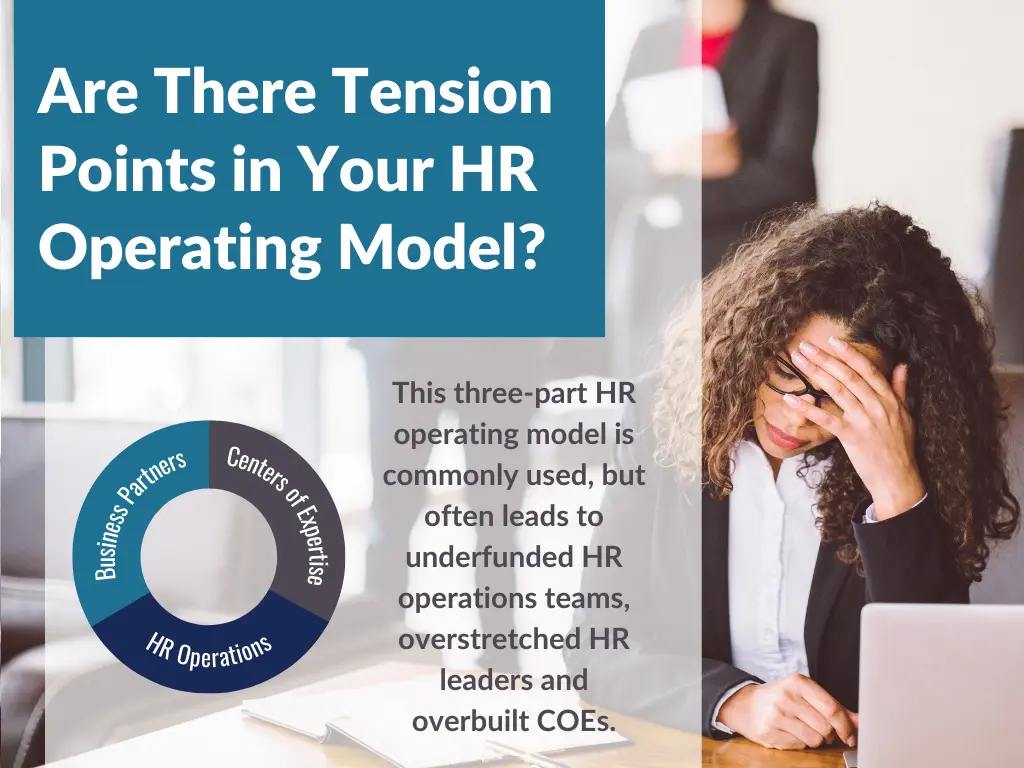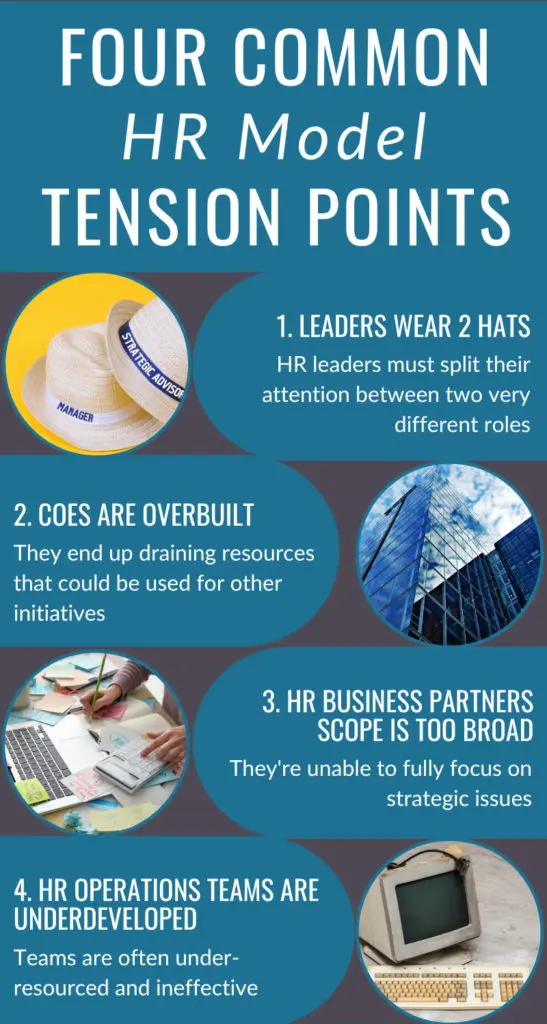We’re all familiar with recent shifts in the workplace that have left HR professionals scrambling to catch up. Yet even as HR leaders address trends like The Great Resignation and hybrid work, they may find their work is also hindered by internal tensions – HR leaders spread too thin and HR service platforms that are outdated, to name just a few.
Why do these issues arise, and why do we see them so frequently in our work with clients? To understand the problem, we must first look at how HR departments are designed. For the last several decades, most HR functions have been organized using David Ulrich’s three-box approach. This approach segments HR into the following:
Business Partners – Individuals or small teams that serve as HR consultants to managers, senior leaders and staff members. Their primary job is to offer strategic advice that is tailored to the needs of each business unit.
Centers of Expertise – Small teams of experts that specialize in areas like recruitment, benefits, or organization design. They create policies and programs to meet the needs of the organization.
HR Operations – Also known as shared service centers, these employees handle common administrative duties like payroll processing and benefits enrollment for all units across the organization.

Although Ulrich’s model has has many benefits, we often find that it leads to four tension points which can prevent HR functions from working efficiently. Let’s explore these areas in more detail.
4 Tension Points Common in HR Functions
HR Leaders Wear Two Hats
Leaders often expect chief human resource officers to juggle two critical roles. The first is managing the entire HR function. They must deal with day-to-day matters like ensuring that COEs are working on the right initiatives and approving new data privacy guidelines. Second, they’re expected to serve as advisors to company leaders, helping them set policies, manage talent and shape strategy. This requires an in-depth understanding of important issues like corporate culture and recruitment. Balancing these two essential but very different roles can be a challenge for even the most skilled chief resource officers.
Centers of Expertise are Overbuilt
Imagine the family sedan. It doesn’t need a Ferrari engine to navigate the school drop-off lane. We can apply the same logic to COEs. In the early days of a company, COEs with a “Ferrari engine” may be necessary to design every policy and program. Once you implement these practices, the amount of work will taper off and you’ll be left with overbuilt COEs. The COEs may find themselves making up work to do and draining resources that could be used for more valuable initiatives within the organization.
HR Business Partner’s Scope is Too Broad
Imagine you’re an employee who suspects a coworker of stealing from the company. Who should your business unit turn to for help? All too often, it’s the HR business partner. Ideally, HR business partners should consult only on strategic or organizational issues. Their focus should be on issues like managing succession or maximizing organization effectiveness, not tactical matters. As we’ve written before, they may instead become the “heads, heart, hands and legs of HR.” They are often seen as the de-facto HR representative and can find themselves pulled into people-related matters, even if they’re not the appropriate resource.
HR Operations Teams and HR Technology Platforms are Underdeveloped
HR operations teams, also known as shared services or shared service centers, handle administrative duties for units across the organization. They’re charged with managing critical services like payroll, benefits enrollment and self-service tools and platforms. However, leaders often under-resource these operations teams. As a result, the teams lack the robust technology they need to be truly effective.
Additionally, HR leaders may over-react to negative feedback from employees being asked to rely on HR operations and HR self-service tools. As we mentioned above, employees are often more comfortable working with their familiar HR business partner. This pushback often results in leaders assigning COEs and business partners much of the work that should instead be given to HR operations.

Resolving the Tension Points
Fortunately, none of these tension points are unfixable. Leaders should think of Ulrich’s three-pronged model as a flexible blueprint. By modifying the blueprint, they can address these common tension points and better meet their organization’s strategic needs.
In future blogs, we’ll address each of the four tension points in more detail and explore solutions you can use to overcome them. For an in-depth study of this topic, we invite you to download our most recent Executive Guide, Maximizing the HR Operating Model.
